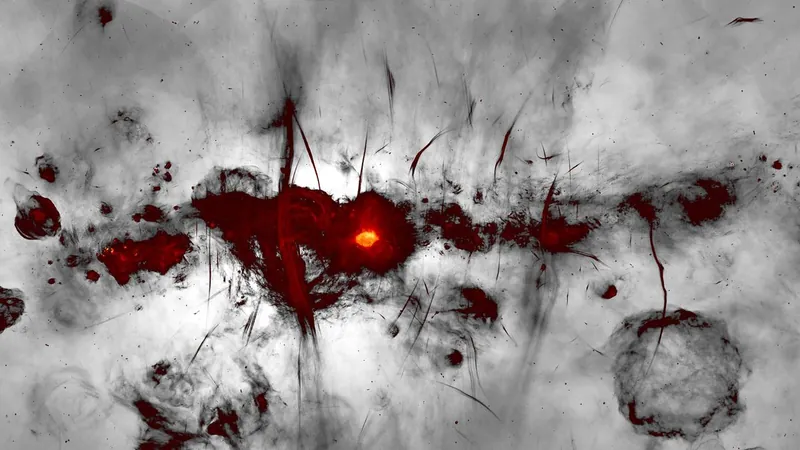
Unveiling the Mysteries of Space Tornadoes: A Groundbreaking Discovery at the Milky Way's Core!
2025-03-25
Author: John Tan
Introduction
In a remarkable advancement in astrophysics, scientists have captured their clearest observations yet of mysterious "space tornadoes" swirling around the supermassive black hole at the center of our Milky Way galaxy. Using the Atacama Large Millimeter/submillimeter Array (ALMA) in Chile, astronomers have unveiled these cosmic phenomena in unprecedented detail, revealing new insights that could change our understanding of galactic dynamics.
Observations with ALMA
Previously detected but never seen in such clarity, these spinning structures were observed with ALMA's technology, which provides images 100 times sharper than earlier attempts. This cutting-edge research, detailed in a recent paper published in the journal Astronomy & Astrophysics, focused on a region of the galaxy known as the central molecular zone (CMZ). This area, teeming with dense clouds of dust and gas, encircles the supermassive black hole and is critical for studying the activities occurring at our galaxy's energetic core.
Research Focus and Findings
The team aimed to demystify the forces driving the chaotic movements of these gaseous clouds. To achieve this, they employed ALMA to identify specific molecular compounds—most notably silicon monoxide, which is excellent for spotting shock waves within the turmoil. Their findings unveiled unprecedented detail, including a previously unobserved type of elongated, slender filament. These intriguing filaments appear to be created from the shock waves pushing through the surrounding material.
Scientific Insights
Astrophysicist Kai Yang from Shanghai Jiao Tong University, who led the study, expressed his astonishment at these new observations: "Unlike any objects we know, these filaments really surprised us. They seem to move rapidly and in a direction opposite to the surrounding structures." This unexpected behavior has provoked excitement and curiosity within the scientific community.
The Nature of Space Tornadoes
The researchers categorize these filaments as space tornadoes, describing them as violent streams of gas that dissipate rapidly yet effectively redistribute material throughout their environment. In their study, the team noted that these whirlwinds might not only emit silicon oxide but also disperse complex organic molecules—such as methanol, methyl cyanide, and cyanoacetylene—across the CMZ and potentially beyond.
Implications and Future Research
Yichen Zhang, another researcher from Shanghai Jiao Tong University and co-author of the paper, emphasized the significance of ALMA's high angular resolution and sensitivity, stating, "These capabilities were essential for detecting the molecular emissions linked to the slender filaments, confirming their existence independent of dust emissions."
As this groundbreaking work continues, further ALMA observations are planned to explore the extent of these slender filaments throughout the CMZ and their role in the broader processes of molecular cycling in this vibrant and tumultuous section of the galaxy. As we delve deeper into these cosmic wonders, we may uncover vital clues about the formation of galaxies and the complex chemical processes that could be the precursors to life itself!
Conclusion
Stay tuned as this story unfolds and opens a window into the unseen forces shaping our universe!


 Brasil (PT)
Brasil (PT)
 Canada (EN)
Canada (EN)
 Chile (ES)
Chile (ES)
 Česko (CS)
Česko (CS)
 대한민국 (KO)
대한민국 (KO)
 España (ES)
España (ES)
 France (FR)
France (FR)
 Hong Kong (EN)
Hong Kong (EN)
 Italia (IT)
Italia (IT)
 日本 (JA)
日本 (JA)
 Magyarország (HU)
Magyarország (HU)
 Norge (NO)
Norge (NO)
 Polska (PL)
Polska (PL)
 Schweiz (DE)
Schweiz (DE)
 Singapore (EN)
Singapore (EN)
 Sverige (SV)
Sverige (SV)
 Suomi (FI)
Suomi (FI)
 Türkiye (TR)
Türkiye (TR)
 الإمارات العربية المتحدة (AR)
الإمارات العربية المتحدة (AR)